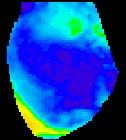|



What follows is an informal compilation of
the voltage-sensitive dyes that have been used in a variety of preparations.
The information includes dye source, signal size, staining conditions,
and pharmacological- and photo-toxicity. In a few instances several
dyes have been tested. In some cases the data is presented directly,
in others a reference is given, and in some cases both. You can
contact the individual scientist directly for additional or more
up-to-date information.
The dyes with the label WW were synthesized by Jeff Wang and Alan
Waggoner, then at Amherst College. Dyes labeled RH were synthesized
by Rina Hildesheim and Amiram Grinvald at the Weizmann Institute.
Dyes labeled JPW were synthesized by Joe Wuskell and Les Loew at
the University of Connecticut Health Center. We depend on them.
Dissolving the dyes can be tricky in that they may look dissolved
but still be in small crystals. You can check this out by filtering
through a Millipore filter. If the dye was not dissolved, try modest
warming (e.g. 50°C). Hydrophobic dyes will require more extensive
procedures involving ethanol and Pluronic F127.
· Embryonic chick and rat heart
Adult frog and rat heart Embryonic chick and rat CNS (6/99)
· Rat, neonatal cardiac myocytes in culture (6/99)
| Signal
type: |
Absorption |
| Dye names: |
NK2761,
NK2776, NK3224, NK3225 |
| Supplier: |
Nippon
Kankoh Shikiso Kenkyu-sho |
| Concentration: |
0.2
mg/ml |
| Staining
duration: |
20
minutes |
| Signal-to-noise
ratio: |
5:1
(guinea pig); 3:1 (mouse) |
Fractional
change ( F/F): F/F): |
10-4
to 10-3 |
| Pharmacology: |
negligible |
| Phototoxicity: |
negligible |
#Kamino, K., Hirota, A., and Fujii, S. (1981
) Localization of pacemaker activity in early embryonic heart
monitored using voltage sensitive dyes.
Nature. Apr 16;290(5807):595-7
*Momose-Sato, Y., Sato, K., Sakai, T., Hirota, A., Matsutani K.,
and Kamino, K. (1995) Evaluation of optimal voltage sensitive
dyes for optical monitoring of embryonic neural activity. J.
Membrane Biology 144: 167-176.
* Rohr S, Salzberg BM. (1994) Multiple
Site Optical Recording of Transmembrane Voltage (MSORTV) in Patterned
Growth Heart Cell Cultures: Assessing Electrical Behavior, with
Microsecond Resolution, on a Cellular and Subcellular Scale.
Biophysical Journal 67(3):1301-15.
|


